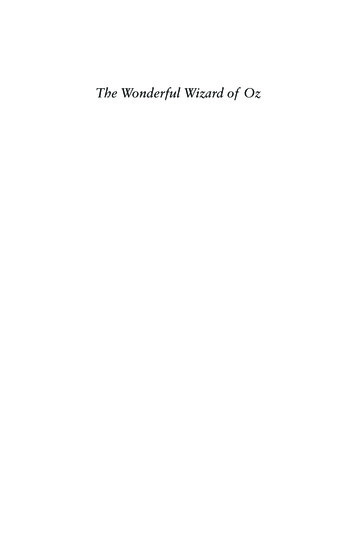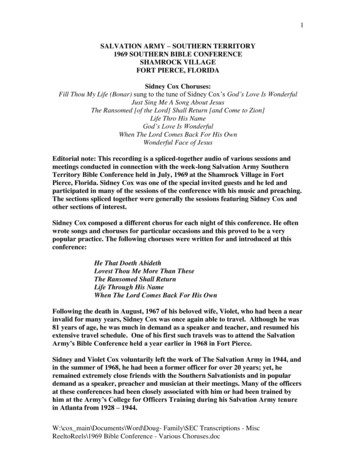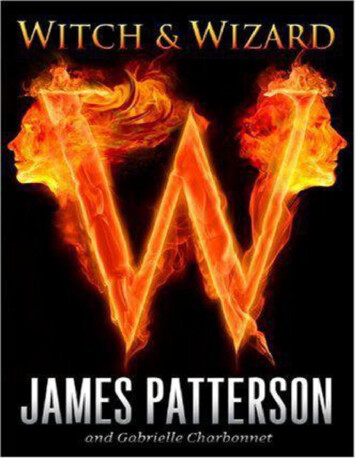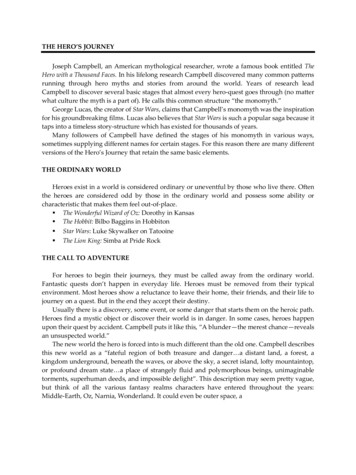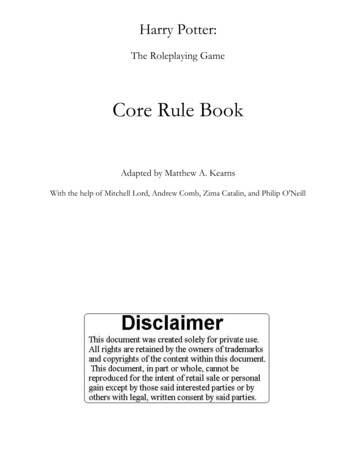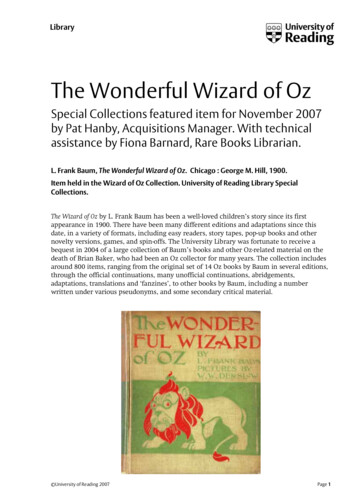
Transcription
Pat HanbySection nameLibraryThe Wonderful Wizard of OzSpecial Collections featured item for November 2007by Pat Hanby, Acquisitions Manager. With technicalassistance by Fiona Barnard, Rare Books Librarian.L. Frank Baum, The Wonderful Wizard of Oz. Chicago : George M. Hill, 1900.Item held in the Wizard of Oz Collection. University of Reading Library SpecialCollections.The Wizard of Oz by L. Frank Baum has been a well-loved children’s story since its firstappearance in 1900. There have been many different editions and adaptations since thisdate, in a variety of formats, including easy readers, story tapes, pop-up books and othernovelty versions, games, and spin-offs. The University Library was fortunate to receive abequest in 2004 of a large collection of Baum’s books and other Oz-related material on thedeath of Brian Baker, who had been an Oz collector for many years. The collection includesaround 800 items, ranging from the original set of 14 Oz books by Baum in several editions,through the official continuations, many unofficial continuations, abridgements,adaptations, translations and ‘fanzines’, to other books by Baum, including a numberwritten under various pseudonyms, and some secondary critical material. University of Reading 2007Page 1
The first edition of the book that most people know as The Wizard of Oz was published in1900 by George M. Hill as The Wonderful Wizard of Oz [front board shown above], withillustrations by W.W.Denslow. It has a complicated publishing history, and there are manyvariants, even within editions. The first printing of the first edition contained a few spellingmistakes, and these were corrected in the second printing. The second edition waspublished in 1903 by Bobbs-Merrill as The New Wizard of Oz, which was shortened on thecover to the more familiar title of The Wizard of Oz for the second printing. This edition hadfewer illustrations than the original, and later ones reduce these still further, in particularchanging the colour plates to black and white full page illustrations. The text illustrationswere also printed in black and white, rather than in colour, and were separated from thetext rather than being closely linked as in early editions. A notable later edition is the 1939MGM movie edition, which includes colour stills from the film. Another is the Hutchinsonedition of 1947 which has very few of Denslow’s illustrations – mainly the chapter headingsand a small picture at the end of each chapter, - but does have five colour plates by H.M.Brock [see frontispiece below], which add to its interest. From 1939 onwards there were manyrewritten versions with illustrations by other authors.The University of Reading Library edition appears to be the second printing of the firstedition as the spelling mistakes are corrected, though it may contain some colour platesfrom the first printing. As production was in three separate components – the text, thecolour plates, and the binding case - copies containing elements of both printings are oftenfound. The partnership of Baum and Denslow produced a book which is exceptional inmany ways. It is an extremely lavish production, with an innovative combination of textand illustrations. Baum and Denslow had already collaborated on Father Goose; His Book in1899, and in The Wonderful Wizard of Oz, they produced a landmark classic which has becomethe most popular and successful children’s fantasy ever published in America, with adeserved popularity overseas as well. University of Reading 2007Page 2
The first edition has 24 tipped-in full colour plates, including a delightful title-page [seeabove]. All the memorable events of the story have their own picture, including Dorothy’smeeting with each of her three companions. First there is the Scarecrow, then the TinWoodman [see below], University of Reading 2007Page 3
and lastly the Cowardly Lion [see below]. In this plate there is an instance of part of thepicture overspilling the frame, which adds to its interest, and occurs in other plates as well,including the meeting with the field mice where there is a mouse sitting on top of theframe, and another in the bottom corner, with his tail linked into the picture [see below]. University of Reading 2007Page 4
However, the most innovative illustrations are those in the text, where words and imagesintertwine with one another, with text printed over pictures, or formatted in odd shapes tofit around them. Many chapters begin with an illustrated first letter in the style of anillumination, so that at the very beginning we have Dorothy leaning on the capital letter ‘D’[see below],and throughout the text there are large and small illustrations scattered under, over, aroundand through the text. There is hardly a page, except those facing and after the colour plates,that has no decoration, usually in a single colour. Each chapter begins with a full pagecolour illustration, for example chapter 8, The Deadly Poppy Field [see below], which is inshades of orange and brown, with Dorothy and Toto lying asleep under giant poppies. University of Reading 2007Page 5
There are some delightful double page spreads, such as pages 104-5 [see below] where thefield mice are dragging the sleeping lion from the poppy field. Looking carefully at themice, one can see that they have individual faces, obviously struggling with their heavyload. The field mouse queen sits on her haunches watching regally.Chapter 11, The Wonderful Emerald City of Oz has many green illustrations, to match thetext where the word “green” is constantly repeated. Pages 124-5 are a good example of textand picture matching perfectly. The text is overprinted on the green backgroundillustration, which includes a nice row of books. University of Reading 2007Page 6
As a story for children, it works on several levels. At the beginning there is a detaileddescription of the very ordinary house where Dorothy lives with Aunt Em and Uncle Henry– all very humdrum and everything seems grey. There is Dorothy’s pet dog Toto [see below] –animals feature in all the best children’s stories.Then there is the cyclone which picks up the house with Dorothy and Toto in it and putsthem down in a strange country. From then on, a series of magical episodes leads Dorothythrough strange lands with fairy-tale companions, climaxing in the arrival at the EmeraldCity of Oz.They are then sent on a quest by the Wonderful Wizard of Oz and their success is rewardedin gaining what they most desire. Oz turns out to be a humbug [see above], but he is still ableto satisfy three of the four companions. The scarecrow gets brains – his head is stuffed with University of Reading 2007Page 7
bran and pins and needles so that he has “bran-new brains” and is very sharp. The TinWoodman gets a beautiful heart made of silk and stuffed with sawdust, which Oz tells himis a kind heart. The Cowardly Lion is given courage – Oz makes him drink the contents of asquare green bottle. Each believes he has what he wants. However, Oz fails in his attempt tosend Dorothy back to Kansas, going up himself in the air balloon never to be seen again.The many magical elements to the story are fittingly illustrated. The wearer of the GoldenCap can call upon the Winged Monkeys three times to fulfil a request, which can be eithergood or evil. The Wicked Witch of the West calls on them to destroy the Tin Woodman andthe Scarecrow, and to bind up the Cowardly Lion [see below].However, when Dorothy calls on them [see below], she and her companions are rescued andare flown back to the Emerald City. However, even the Winged Monkeys cannot flyDorothy back to Kansas, although they are able to rescue her and her companions from theHammer-Heads and take them to the land of the Quadlings, where they find the GoodWitch of the South. Glinda, the Witch, is given the Golden Cap and her three wishestransport three of the company to places where they can use the gifts given to them by Oz.The Scarecrow returns to rule the Emerald City, The Tin Woodman goes back to rule overthe Winkies, and the Lion goes back to the forest to become King of the Beasts. University of Reading 2007Page 8
Finally Glinda tells Dorothy the secret of the Silver Shoes, which she has been wearing sincethe beginning of the journey, having taken them from the feet of the Wicked Witch of theEast who was killed when Dorothy’s house landed in the country of the Munchkins. Theshoes take her safely home to Kansas and the story ends with her happy return home “Andoh, Aunt Em! I’m so glad to be home again!”As well as presenting a satisfying story, the lavish production would have delighted themany children who received it at Christmas in 1900. It was followed by 13 sequels fromBaum, though the illustrator after the first book was John R. Neill. Following Baum’s death,several others continued the series until the final official sequel, no 40. Merry Go Round in Oz.John R. Neill continued as illustrator until the 36th book, and in fact wrote three bookshimself, so the format remained consistent, and their popularity continued. Most peoplenow know the story from the MGM film, starring Judy Garland, which still gets shownregularly on television, or as a modern retelling. There are many enthusiasts who collectearly editions avidly, who continue to write ‘fanfic’ and contribute to the several magazines,of which the most significant is The Baum Bugle. The value of first and early editionscontinues to increase, but the magic of the story can still captivate a child. University of Reading 2007Page 9
References Baum, L. Frank, The Wizard of Oz, line illustrations by W. W. Denslow, 8 colour stills fromthe MGM film. Hutchinson, 1940. Baum, L. Frank, The Wizard of Oz, line illustrations by W. W. Denslow, colour illustrationsby H.M. Brock. Hutchinson, 1947. Greene, Douglas G. and Hanff, Peter E. Bibliographia Oziana, (International Wizard of OzClub, rev. ed. 1988. Richardson, Barbara, ‘L. Frank Baum and “The Wizard of Oz”, Book and Magazine Collector,no. 201, Dec. 2000, pp. 46-62. Richardson, Barbara, ‘Wonderful Wizard : L. Frank Baum’, Book and Magazine Collector, no.268, May 2006, pp 42-58. University of Reading 2007Page 10
The first edition of the book that most people know as The Wizard of Oz was published in 1900 by George M. Hill as The Wonderful Wizard of Oz [fro
